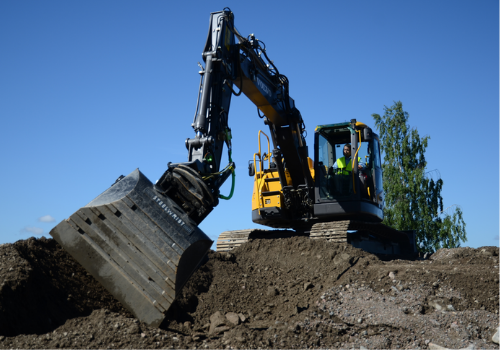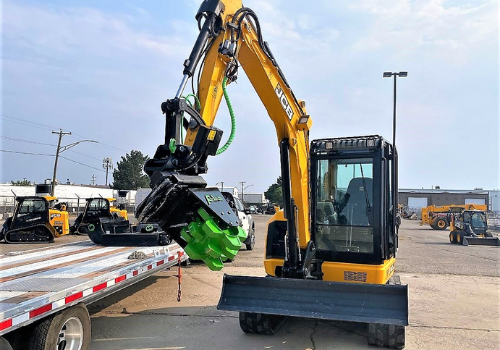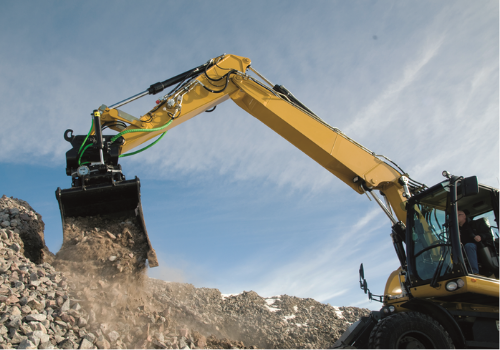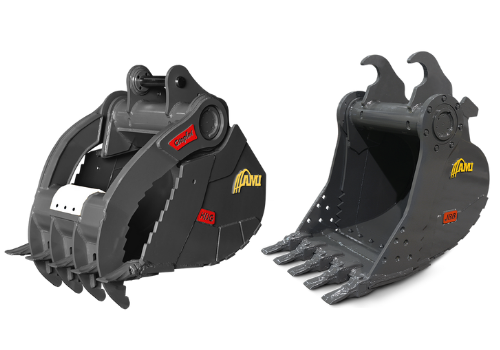
Buckets and rippers and blades, oh my!
Utility contracts have a dizzying array of choices when it comes to attachments for compact construction equipment. Whether purchasing attachments as part of a new machine package or adding options to an existing unit, contractors should weigh application, operability and cost.
The right attachments add efficiency and versatility to base equipment, according to Caleb Jackett, product specialist with AMI Attachments in Hawksville, Ontario, Canada. “An efficient attachment saves fuel and labor. The more versatile the attachment, the more contractors can get out of their compact machines.”
MATCH BUCKETS TO APPLICATION
Buckets are among the most commonly used attachments for compact excavators. “It’s important to match the bucket to the application by selecting the correct width profile,” Jackett says. “The deeper you need to dig, the narrower the bucket to make it easier to penetrate the ground.”
“With narrow trenching buckets, you pull out less material, disturb less landscape and need less time to cover the hole afterwards,” he says. Wider grading buckets are ideal when operators want to spread as much material as possible and level ground quickly. By using only the width of bucket needed for the job, the operator can avoid generating excess spoils that are costly to either refill or haul away.
Other bucket options include sewer buckets that have wider teeth for handling wet material and cabling buckets with longer profiles to increase the machine’s reach and allow for straighter cuts.
Screening buckets are growing in popularity to recycle material on the job site, adds Christian Yanes, vice-president of Region America at Steelwrist, a Swedish company with U.S. operations in Berlin, Connecticut.
“The operator can pull out the material and screen out the rocks for refilling, rather than purchasing and transporting fill or topsoil,” Yanes says.

COMPACTION CONSIDERATIONS
Compaction attachments are must-have tools for utility contractors. Soil type, moisture and compaction requirements are important considerations.
“Some areas require soil testing and mandate 90% or higher compaction after a job is completed,” says Shawn Pabst, chief executive officer at Felco Industriesin Missoula, Montana. “It’s important to understand soil conditions on the site to determine the best compactor for the job.”
Wheel compactors deliver static downward pressure to compact soil. These compactors don’t require hydraulic lines and are best suited to clay-based soils. Hydraulic vibratory compactors bounce up down rapidly to compact sandy or less cohesive soils.
For more efficiency, a vibratory compactor combined with a bucket attachment allows the operator to lift and compact the spoils with the same tool.
“After grabbing the spoils and laying out the proper lift depth, the operator curls in the bucket and hits the hydraulics to compact,” says Pabst. “This speeds up the backfill and compaction process by not having to switch back and forth between attachments.”
Another solution for backfill material management is a bedding box attachment for skid steers. These tools are ideal for bedding with non-native materials.

360-DEGREE ROTATION
Tiltrotators are popular in Europe and gaining awareness and adoption in the U.S. These innovations allow attachments to rotate 360 degrees and tilt in both directions to increase mobility and efficiency.
They use a standard high flow hydraulic line and can be installed on any size excavator – as either a new or retrofit option.
“Utility contractors often have to work in tight spots where mobility is limited. Nearby buildings may hinder movement, or there may be concerns with pedestrians and traffic,” says Yanes.
“Rather than repositioning the machine to complete the job, a tiltrotator allows the operator to maneuver and reposition the tool,” he says.
Tiltrotators allow the machine and operator to do more work in less time and reduce the manpower needed on-site. Although expensive to purchase, tiltrotators can improve machine efficiency by 20 to 35 percent, Yanes says. They also reduce hazards associated with moving machines from place to place within the job site.
SAFETY FEATURES
Safety is another purchase consideration for compact equipment attachments.
“You want as much capacity as possible in your attachment but be aware of its weight compared to the machine. If the attachment is too heavy for the machine, it may be prone to tipping,” says Jackett.
As a rule of thumb, Pabst recommends attachment weight does not exceed 7% of the operating weight of the machine. “If an attachment is too heavy it may overwhelm the machine,” he says.
Ask the manufacturer for data on lifting capabilities and weight limits. All attachments are built to withstand the capacity for the machine and will not fail unless used for an application they were not intended for.
Most machines are equipped with quick coupler or quick connect features that also improve safety. These features allow the operator to drop one attachment and reattach another without leaving the seat.
“For example, while digging a narrow trench with a 12-inch bucket, an operator may encounter a rock. With a quick coupler it is easy to connect a ripper attachment with more breakout force needed to eliminate the rock, then switch back to the bucket attachment,” says Yanes.
The functionality of most quick couplers is limited in that the operator must manually connect hydraulic hoses. However, new automatic quick coupling technology allows the operator to connect hydraulics from the cab. Integrated hydraulic connectors save time and reduce potential danger from hydraulic oil spills, Yanes says.

RENT OR BUY?
For more expensive or less-frequently-used attachments, contractors may want to consider renting rather than purchasing.
“The more specialized the attachment, the greater the desire to rent,” says Pabst. “But on the other hand, dealers may not stock highly specialized equipment in their rental fleets because of lower demand.”
A hydraulic hammer is a frequently stocked rental attachment because it is both specialized and expensive to buy. Stand-alone hydraulic plate compactors and wheel compactors are also common rentals because of their versatility in a wide variety of applications.
Pabst advises contractors to discuss attachment needs with equipment rental companies well in advance of projects. “The rental company may have solutions in stock. Or they may need to pull attachments from another location,” he says. When renting, contractors should be aware that not all attachments are compatible with every machine. Check specifications to avoid surprises.
Whether renting or purchasing, contractors should be aware that attachments are in high demand. As with other types of equipment, expect long lead times for manufacturers to build and ship new attachments.
TECHNOLOGY TRENDS
Attachment technology continues to advance to meet utility job site needs.
“An exciting development is potential compatibility of tiltrotators with grade controls,” says Jackett. “New software packages use GPS to direct the control stick in the cab to automatically achieve the needed depths, angles and slopes based on the blueprint or site plan. Anything that reduces the complexity of equipment operation can reduce labor, make the site more efficient and improve the quality of the work.”
BRANDS FEATURED IN THIS ARTICLE:
Subscribe to The Utility Expo monthly newsletter to receive more industry insights like this.
